
Catalog excerpts

Assistive and Assistive and passive training
Open the catalog to page 1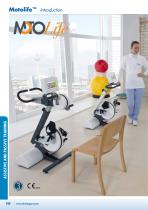
ASSISTIVE AND PASSIVE TRAINING Motolife™ Introduction
Open the catalog to page 2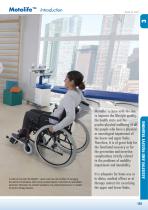
Motolife™ is born with the aim to improve the lifestyle quality, the health state and the psycho-physical wellbeing of all the people who have a physical or neurological impairment of the lower and upper limbs. Therefore, it is of great help for the functional recovery or for the prevention and invertion complications strictly related to the problems of mobility impairment and immobility. In order to train with the Motolife™, users must have the condition of managing the device by themselves, after having received specific instructions by specialized personnel. Otherwise, the constant...
Open the catalog to page 3
Motolife™ Therapeutic indications Benefits of the movement therapy with the use of a motorized cycle-ergometer are widely treated in several international papers. They deal mainly with the prevention or invertion of complications which are directly linked to the lack of movement and mobility and especially with the reduction of muscle spasticity, the muscle atrophy caused by immobility, the increase of specific peripheral circulation and the improvement or maintenance of the joint mobility and the slow-down of the case history of neurological pathologies such as a stroke, multiple...
Open the catalog to page 4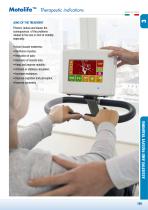
Motolife™ Therapeutic indications Prevent, reduce and lessen the consequences of the problems related to the loss or limit of mobility especially: ASSISTIVE AND PASSIVE TRAINING • Avoid muscle weakness; • Reinforce muscles; • Reduction of pain; • Recovery of muscle tone; • Keep and improve mobility; • Activate or stabilize circulation; • Increase resistance; • Improve cognition and perception; • Impr
Open the catalog to page 5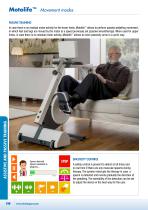
Motolife™ Movement modes PASSIVE TRAINING ASSISTIVE AND PASSIVE TRAINING In case there is no residual motor activity for the lower limbs, Motolife™ allows to perform passive pedalling movement, in which feet and legs are moved by the motor at a speed previously set (passive kinesitherapy). When used for upper limbs, in case there is no residual motor activity, Motolife™ allows to move passively arms in a cyclic way. SPASTICITY CONTROL A safety control is present to detect at all times and in real time if there are any muscular spasms during therapy. The system interrupts the therapy in case...
Open the catalog to page 6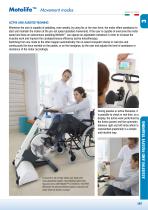
Motolife™ Movement modes ACTIVE AND ASSISTED TRAINING During passive or active therapies, it is possible to check in real time, on a display, the active work performed by the limbs (power) and the symmetry between right and left limbs which is represented graphically in a simple and intuitive way. To avoid the risk of high stress over joints and musculoskeletal system, the pedalling speed with legs and arms with Motolife™ is limited to 100 RPM. Whenever the aforementioned speed is reached, the motor limits its further increase. ASSISTIVE AND PASSIVE TRAINING Whenever the user is capable of...
Open the catalog to page 7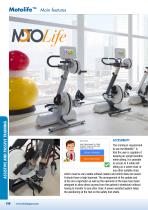
ASSISTIVE AND PASSIVE TRAINING Motolife™ Main features ACCESSIBILITY The minimum requirement to use the Motolife™ is that the user is capable of keeping an upright position while sitting. It is possible to access to it while still sitting on a wheel chair or any other suitable chair, which must be very stable without castors and which does not swivel. It should have a high backrest. The arrangement of the pedals and of the arm-ergometer as well as the elements of the base have been designed to allow direct access from the patient’s wheelchair without having to transfer to any other chair. A...
Open the catalog to page 8
Motolife™ Main features The metal structure of the Motolife™, onto which are fixed the motors, the transmissions, the pedals and the handgrips, has been designed to be balanced and resistant to the stress of active pedalling with arms and legs or by eventually muscular spasticity. The broad base and the levelling rubber feet give the structure the best stability on any kind of horizontal floor. ELECTRONIC FLYWHEEL EFFECT An electronic flywheel effect has been considered and included to reduce the weight and size of the cycle arm-ergometer and to make it easy to move it around. The...
Open the catalog to page 9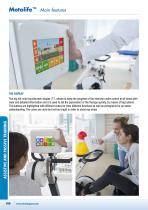
Motolife™ Main features ASSISTIVE AND PASSIVE TRAINING The big full-color touchscreen display (7”), allows to keep the progress of the exercise under control at all times,with clear and detailed information and it is used to set the parameters of the therapy quickly, by means of big buttons. The buttons are highlighted with different colors for their different functions as well as pictograms for an easier understanding. The colors are vivid but not too bright in order to avoid eye strain.
Open the catalog to page 10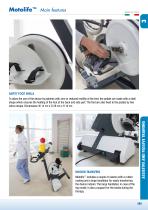
Motolife™ Main features SAFETY FOOT SHELLS INDOOR TRANSFERS Motolife™ includes a couple of castors with a rubber coating and a large handlebar for easily transferring the device indoors. The large handlebar, in case of the leg model, is also a support for the hands during the therapy. ASSISTIVE AND PASSIVE TRAINING To allow the use of the device by patients with zero or reduced motility of the feet, the pedals are made with a shell shape which ensures the holding of the foot at the back and side part. The feet are also fixed to the pedals by two velcro straps. Dimensions: W 14 cm x D 28 cm...
Open the catalog to page 11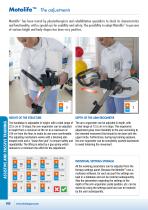
Motolife™ The adjustments Motolife™ has been tested by physiotherapists and rehabilitation specialists to check its characteristics and functionality, with a special eye for usability and safety. The possibility to adapt Motolife™ to persons of various height and body shapes has been very positive. ASSISTIVE AND PASSIVE TRAINING The handlebar is adjustable in height, with a total range of 22.5 cm in 10 steps, the arm-ergometer can be adjusted in height from a minimum of 90 cm to a maximum of 109 cm from the floor, to make its use more comfortable. The adjusting mechanism works with a...
Open the catalog to page 12
TILTING DISPLAY The display support can be tilted even up to a horizontal position. This allows a perfect visibility at any light condition and the possibility for the therapist to set the parameters without the need of having to bend down. PEDAL POSITION According the user’s ergonomic measurements and to the therapy needs, it is possible to adjust the pedal radius by three sizes: 5 cm, 8.5 cm and 12 cm. For each user the established position can be stored in the settings of the legs therapy and it can be recalled subsequently. ASSISTIVE AND PASSIVE TRAINING HANDLE POSITION In the legs and...
Open the catalog to page 13All Chinesport catalogs and technical brochures
-
Pulley therapy
30 Pages
-
Electromedical equipment
56 Pages
-
Professional tables
94 Pages
Archived catalogs
-
LIGHT CHAIR
1 Pages
-
VOD 56
2 Pages
-
FISIOTEK HP2
4 Pages
-
FISIOTEK 2000
4 Pages
-
FISIOTEK LT
4 Pages
-
TENS eco 2
2 Pages
-
Posture Analysis Systems
20 Pages
-
17_Relax Chairs
10 Pages
-
16_Hygiene and anti-decubitus
28 Pages
-
15_Hoisting and Transfer
14 Pages
-
08_Parallel Bars and Staircases
22 Pages
-
11_Tractions
16 Pages
-
09_Walking Aids
12 Pages
-
03_Rehabilitation
42 Pages
-
02_Electro-medical Equipment
36 Pages
-
WHEELCHAIRS AND HOSPITAL BEDS
16 Pages
-
RELAX CHAIRS .
10 Pages
-
HYGIENE AND ANTI-DECUBITUS
28 Pages
-
HOISTING AND TRANSFER
14 Pages
-
Diagnostics
22 Pages
-
hydrotherapy
10 Pages
-
Medical Gymnastics
24 Pages
-
Traction
16 Pages
-
Treadmills
10 Pages
-
Walking Aids
12 Pages
-
Parallel Bars and Staircases
22 Pages
-
Pulley Therapy
30 Pages
-
Standing Frames
30 Pages
-
Occupational Therapy
36 Pages
-
Therapy tables
48 Pages
-
REHABILITATION
42 Pages
-
electro medical device
36 Pages
-
Hospital Beds
2 Pages
-
Parallel bars
2 Pages
-
Tilt
12 Pages











































